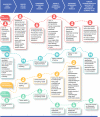How can we deliver on the promise of precision medicine in oncology and beyond? A practical roadmap for action
- PMID: 37359405
- PMCID: PMC10286856
- DOI: 10.1002/hsr2.1349
How can we deliver on the promise of precision medicine in oncology and beyond? A practical roadmap for action
Abstract
Background: Precision medicine (PM) is a form of personalized medicine that recognizes that individuals with the same condition may have different underlying factors and uses molecular information to provide tailored treatments. This approach can improve treatment outcomes and transform lives through favorable risk/benefit ratios, avoidance of ineffective interventions, and possible cost savings, as evidenced in the field of lung cancer and other oncology/therapeutic settings, including cardiac disease, diabetes, and rare diseases. However, the potential benefits of PM have yet to be fully realized.
Discussion: There are many barriers to the implementation of PM in clinical practice, including fragmentation of the PM landscape, siloed approaches to address shared challenges, unwarranted variation in availability and access to PM, lack of standardization, and limited understanding of patients' experience and needs throughout the PM pathway. We believe that a diverse, intersectoral multistakeholder collaboration, with three main pillars of activity: generation of data to demonstrate the benefit of PM, education to support informed decision-making, and addressing barriers across the patient pathway, is necessary to reach the shared goal of making PM an accessible and sustainable reality. Besides healthcare providers, researchers, policymakers/regulators/payers, and industry representatives, patients in particular must be equal partners and should be central to the PM approach-from early research through to clinical trials and approval of new treatments-to ensure it represents their entire experience and identifies barriers, solutions, and opportunities at the point of delivery.
Conclusion: We propose a practical and iterative roadmap to advance PM and call for all stakeholders across the healthcare system to employ a collaborative, cocreated, patient-centered methodology to close gaps and fully realize the potential of PM.
Keywords: collaborative precision medicine; equitable access precision medicine; patient engagement; precision medicine.
© 2023 The Authors. Health Science Reports published by Wiley Periodicals LLC.
Conflict of interest statement
Sandra Blum is an employee of Roche, Basel, Switzerland. Tanya Knott reports consulting fees from Rare Revolution, support for meeting attendance/travel from Roche Products Ireland ESMO Sponsorship, and Roche Sponsorship for hosting World CUP Awareness Week. Sandra Blum, Tanya Knott, C. Benedikt Westphalen, Begonya Nafria, and Durhane Wong‐Rieger hold a leadership or fiduciary role in the “From Testing to Targeted Treatments” (FT3) Board. Helena Harnik, Nicholas Brooke and Nicole Wicki are collaborating with The Synergist, a nonprofit organization, whose programs, including the FT3 program, are sponsored by the industry. However, the authors declare that these supporting funding sources/financial relationships and additional roles did not provide any conflict of interest with this project. All other authors declare that they have no conflicts of interest. The views and opinions of the authors here do not reflect the opinions of their respective organizations; they reflect personal accounts from the varied expertise and perspectives. All authors are members of FT3, and all had a role in the design of the project, review, and interpretation of PM initiatives identified, including PM case studies; writing/reviewing of the report; and the decision to submit the report for publication.
Figures



References
-
- MedlinePlus . What is Precision Medicine? MedlinePlus; 2021.
-
- European Commission . Definition of Personalised Medicine. European Commission; 2021.
-
- Wilsdon T, Barron A, Edwards G, et al. The Benefits of Personalised Medicine to Patients, Society and Healthcare Systems. Charles River Association; 2018:1‐72.
-
- Personalized Medicine Coalition . Moving Beyond Population Averages. A Patient‐Centered Research Agenda Advancing Personalized Medicine. PMC; 2020.
-
- Peck RW. The right dose for every patient: a key step for precision medicine. Nat Rev Drug Discov. 2016;15:145‐146. - PubMed
LinkOut - more resources
Full Text Sources
Miscellaneous

